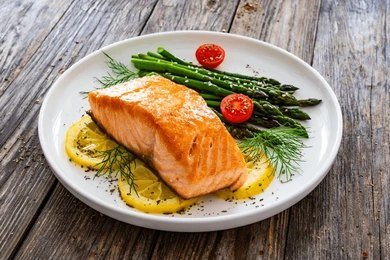Salmon is a powerhouse of nutrition, offering a delectable combination of flavor and health benefits. This popular fish has gained widespread recognition for its impressive nutritional profile, including its calorie content and abundance of essential nutrients. Understanding salmon calories and their impact on overall health has become increasingly important for those seeking to maintain a balanced diet and reap the rewards of this nutrient-dense food.
The health benefits of salmon extend far beyond its calorie content. This article delves into the nutritional facts of salmon, comparing the calories in salmon to other protein sources like chicken. It explores the differences between wild and farmed salmon, highlighting their unique nutritional attributes. Additionally, readers will discover practical ways to incorporate this versatile fish into their diet, unlocking its full potential as a nutritious and delicious meal option.
Read More About: Meat Sweats
Nutritional Profile of Salmon
Salmon is a nutrient-dense fish that offers a wealth of health benefits. A 100g serving of wild Chinook salmon provides 179 calories, with 19.9g of protein and 10.4g of fat. It contains no carbohydrates, making it an excellent choice for low-carb diets. Salmon is rich in omega-3 fatty acids, with 2342mg of omega-3 and 122mg of omega-6 per serving. This fish is also a significant source of essential vitamins and minerals. It provides 52% of the daily value (DV) for selenium, 42% DV for vitamin B3, and 29% DV for phosphorus. Additionally, salmon contains notable amounts of magnesium, vitamin B12, vitamin B6, and potassium. Sockeye salmon, another popular variety, offers a similar nutritional profile with 153 calories, 21.9g of protein, and 7.3g of fat per 100g serving. It is particularly high in vitamin B12, providing 130% of the DV.
Salmon Calories: Health Benefits of Salmon
Salmon has an influence on various aspects of health. It supports brain function due to its high omega-3 fatty acid content, particularly DHA. These fatty acids help with cell communication in the brain, potentially reducing the risk of cognitive decline and Alzheimer’s disease. Salmon also has an impact on heart health by lowering triglycerides, increasing HDL cholesterol, and reducing inflammation. Its protein content aids in weight management by promoting fullness and boosting metabolism. The omega-3s in salmon may also help decrease belly fat. Additionally, salmon contains potassium, which helps control blood pressure, and astaxanthin, an antioxidant that protects against heart disease and inflammation. Regular consumption of salmon has been linked to improved skin health and reduced inflammation throughout the body.
Wild vs. Farmed Salmon
Wild salmon and farmed salmon differ significantly in their life cycles and environmental impact. These are part of a sustainable, supply-driven food system that responds to natural population fluctuations. They have a life cycle integrated into their ecosystem’s natural cycles. Well-managed wild fisheries, like those in Alaska, use science-based data to ensure sustainable harvesting practices. In contrast, farmed salmon are cultivated to meet demand-driven food system requirements. Their operations often rely on unsustainably sourced fish feed and produce high concentrations of pollution and waste toxic to surrounding ecosystems. Farmed salmon systems face sustainability challenges, even with technological advances. The use of pesticides and antibiotics in fish farms poses risks to wild species and ecosystems, potentially leading to antibiotic-resistant microbiota.
Click Here to Understand About: Best Keto Snacks
Incorporating Salmon into Your Diet



Leave a Reply